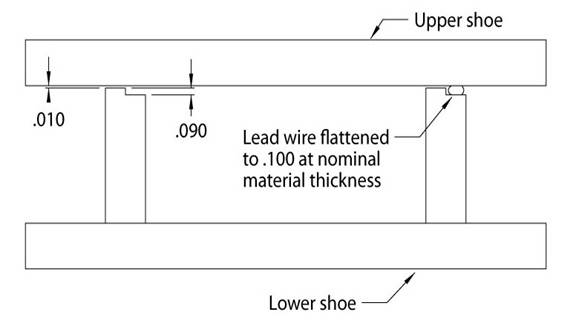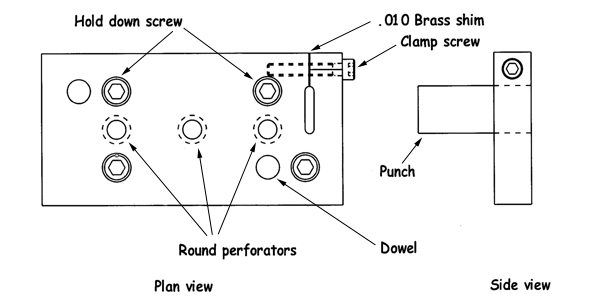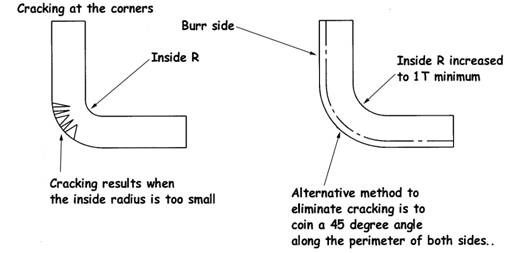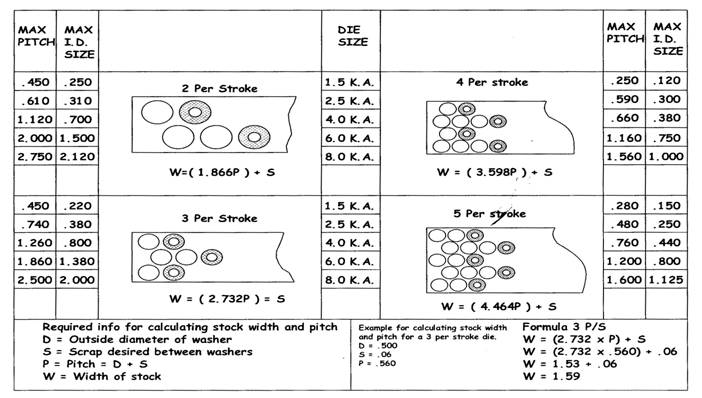Stamping Guidelines

The above alternative to conventional stops is an excellent method to set up dies accurately and enable easy adjustments to shut height when material thickness changes. The die set is engineered to be .010 off the blocks in the closed position with nominal material thickness. A piece of solder wire 5/32 diameter is placed on the block and then the machine is adjusted to squeeze the lead to .100. This would be the set up position with nominal material. Keep in mind that the press may back up slightly and a final adjustment may need to be made.

The above design utilizes the wire EDM process to machine the punch retainer and facilitate easy removal of the slot punch. A precision slip fit pocket is machined out for the punch along with a .010 run out slot for a brass shim. The brass shim prevents over torquing. To remove the punch loosen the clamp screw. This method allows for the use of simple blade type punches where you can also invert the punch for a new cutting edge. This is an excellent method to reduce die maintenance costs and also allows access at the press.

The above screw sizes are general guidelines for construction. When stamping high strength alloys stainless steel fasteners are recommended for all dynamic components such as large punches and retainers. It is also a good practice to replace all fasteners after several sharpening to ensure integrity and avoid sudden die failures and damage. Typically screws are not designed to be removed and re torqued constantly.

The part design and die design needs to be thoroughly evaluated during the design review to eliminate and clarify areas of concern that will affect productivity.

Bend relief is necessary when stamping higher temper material or across the grain direction. A tool steel upgrade or carbide should be considered here for the punches, especially for high production requirements.

Cracking usually occurs in the harder materials when the inside part radius is too small or the form block radius is too small. A good method to eliminate the cracking is to completely coin the burr edge while in the flat position. Polishing and coating the form block radius can add needed lubricity to the operation.

Method of calculating stock width and pitch of a multi-washer die. These dies can be set up as progressive or compound tools.
Stamping and Forming DP/ HSLA High Strength Steels-1
Understanding that the key words in stamping high strength steels are force, support, strength. First we look at all the ways to reduce force requirements without giving up die performance. I am not advocating methodologies to reduce tonnage requirements for the benefit of the press, such as staggering punches or making them different lengths. Although that reduces the press tonnage requirement it hinders die performance because the longest punches will penetrate exceedingly deep. Reducing force can be accomplished by the following:
1. Back taper all the cutting punches wherever possible. Also taper the die sections and buttons ½ degree the entire length to the top surface. This will ensure a free falling slug. Utilize die side slug retention.
2. Shear angles on the punch faces is useful as well (not to exceed metal thickness).
3. Maximize cutting clearance wherever possible. With WEDM it’s possible to machine different clearances (tighter in some areas to help contain scrap).
4. Utilize an appropriate formulated lubricant. The lubricant must be compatible with the application and be applied in the right amount at the right time in the right place.
5. Draw polish all forming tools, especially draw die rings. Draw polishing will increase the life of the tools as well as improve the part finish. Draw polishing can be accomplished economically with AFM (abrasive flow machining).
6. When forming a flange or U shape, score or coin the bend line location in the flat blank stage. This will reduce the force requirement and ensure bend accuracy.
7. Having a rigid, accurate press with the correct tonnage requirement is also critical to success.
The optimal die clearance depends on the type and thickness of the workpiece material (see Figure 6).
© Helfrich Tool and Die Corporation





